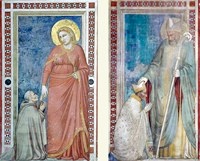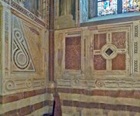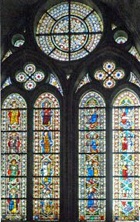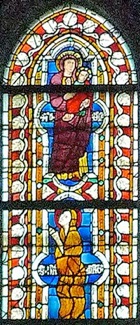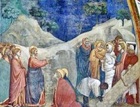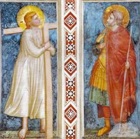This seems to have been the first chapel to be added to the structure of the lower church, in ca. 1296. (The historical context is discussed in the page on the
San Francesco in the 14th century). A number of Cosmatesque panels used to face the lower part of the walls probably came from the original choir screen, which was demolished at this time.
The dedication of the chapel was probably inspired by the fact that the future King Charles II of Naples had discovered what he insisted were relics of St Mary Magdalen at Saint-Maximin, in his county of Provence, in 1279. After he assumed the throne of Naples in 1288, he promoted her cult throughout the kingdom. In the bull (1295) in which he endorsed the of a new basilica at Saint-Maximin and the settlement there of a community of Dominicans, Pope Boniface VIII also endorsed the identification of the relics there, notwithstanding the earlier claims of Vézelay.
The Franciscan Bishop Tebaldo Pontano da Todi of Assisi, who may have commissioned the chapel and who certainly assumed its patronage soon after its completion, had served as Bishop of Castellammare di Stabia (on the Bay of Naples) and at Terracina (also in the Kingdom of Naples) before becoming Bishop of Assisi. He probably became devoted to the cult at that time.
In 1319, when the Ghibelline Muzio di Francesco stole papal treasure that was stored at San Francesco, Pope John XXII held Bishop Pontano personally accountable and confiscated the vestments that he had donated to the chapel. This indicates that the chapel was complete and in use by that time.
The chapel was first documented in two letters sent by Pope John XXII:
-
✴the first, of 1330, records the fact that Bishop Tebaldo Pontano had built the chapel, in which he wished to be buried; and
-
✴the second, of 1332, records that he had promised 600 gold florins for the decoration of the chapel some years before his death, although much of this was still outstanding because Bishop Pontano had been “oppressed with the burden of great poverty”.
Donor portraits of Bishop Tebaldo appear in the lower registers of both the left and the right walls of the chapel (illustrated above):
-
✴in a fresco on the right wall, he wears his Franciscan habit as he kisses the hand of St Mary Magdalene; and
-
✴in a fresco on the left wall, he is shown as a bishop kneeling before St Rufinus.
His arms appear several times in the chapel. He was presumably buried here when he died in 1329 (despite the fact that Assisi was then under a papal interdict), but no trace of his tomb survives.
The chapel passed to Francesco, the brother of Bishop Marcello Crescenzi in 1623 and was re-dedicated to St Bonaventure at that time. It passed to Alessandro Fiumi in 1723.
Stained Glass Windows
The stained glass windows that dominate the back wall of the chapel are considered, on stylistic grounds, to predate the frescoes. They do not contain any overt reference to Bishop Pontano and may therefore have been commissioned before he became the patron of the chapel. The glass was damaged in the 1997 earthquake and has recently been restored.
These windows depict scenes from the life of St Mary Magdalene. The scenes illustrated here (the top two on the right of the left bifore) depict the Madonna and Child and St Mary Magdalene in the desert.
Frescoes (early 14th century)
The frescoes in the chapel were rescued from a thick layer of grime in the late 18th century. Damage later inflicted by Napoleon's troops, by water from a leaking roof, and by a poor restoration in the 1960s has been reversed in the recent restoration.
The restoration has reinforced the attribution of the frescoes to Giotto and his workshop, and they probably belonged to Phase II of the redecoration of the Lower Church (as defined in the page on San Francesco in the 14th Century). This phase also involved:
-
✴most of the right transept; and
-
✴the apse and crossing vaults.
The frescoes are dated on stylistic grounds to a period following his work in the Arena Chapel, Padua (ca. 1305); it is possible that the work was financed by the loan that Palmerino di Guido repaid in Assisi in 1309 on his own behalf and that of “Giotto Bondoni of Florence”.
Scenes from the life of St Mary Magdalene
These seven frescoes depict scenes that are taken from the Golden Legend (ca. 1265) by Jacobus de Voragine, which combined three figures who appeared in the New Testament into the single St Mary Magdalene:
-
✴the sinner who anointed the feet of Christ;
-
✴Mary Magdalene, whom Christ freed from seven devils; and
-
✴Mary, the sister of Martha and Lazarus.
This is the earliest surviving cycle of that kind.
The scenes depict:
-
-
•St Mary Magdalene anointing the feet of Christ in the house of a Pharisee; and
-
•Christ raising Lazarus from the dead (illustrated);
-
-
•the risen Christ appearing to St Mary Magdalene but warning “Noli me tangere” (Do not touch me); and
-
•St Mary Magdalene arriving in Marseille and (lower left) the Governor of Marseille, who had buried his wife on an island after she died during a pilgrimage to Rome, finding her alive on his return journey through the intercession of St Peter (illustrated).
-
✴in the lunettes, from left to right:
-
•St Mary Magdalene is transported by angels in order to receive her final communion in Marseille from St Maximinus (illustrated);
-
•St Mary Magdalene, who lives as a hermit, receives a cloak from another hermit, Zosimus;
-
•St Mary Magdalene in glory receives food from an angel.
Frescoes in the vaults
These roundels contain roundel busts of Christ, the Virgin and SS Mary Magdalene, Martha and Lazarus.
Frescoes under the entrance arch
There are three pairs of saints on each side of the entrance arch from the nave:
-
✴on the left:
-
•SS Peter and Matthew
-
•the “good thief” who was crucified with Christ and St Longinus (illustrated here); and
-
•two female saints; and
-
✴on the right:
-
•SS Paul and the prophet David;
-
•an unknown male saint and St Augustine; and
-
•two female saints.
Read more:
K. Ludwig Jansen, “Making of the Magdalen: Preaching and Popular Devotion in the Later Middle Ages”, (2000) Princeton
L. Schwartz, “Patronage and Franciscan iconography in the Magdalen Chapel at Assisi”, Burlington Magazine, 133 (1991) 32-6
Return to the page on Chapels in the Lower Church.
Return to the main page on San Francesco.
Return to Walk III.
Return to the home page on Assisi.


